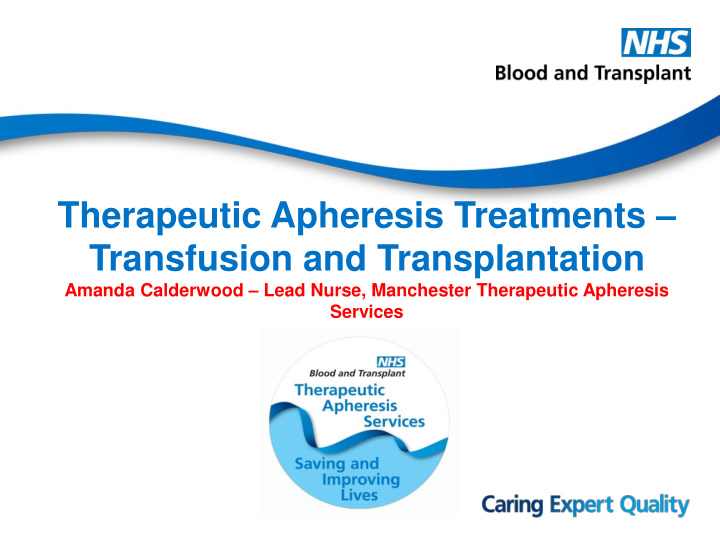



Therapeutic Apheresis Treatments – Transfusion and Transplantation Amanda Calderwood – Lead Nurse, Manchester Therapeutic Apheresis Services
Aims and objectives • Background of Therapeutic Apheresis Services (TAS) • Overview of Apheresis • Treatment outlines • Apheresis Challenges • Questions
Therapeutic Apheresis Services (TAS) • NHSBT has a long history of providing life-saving and life- enhancing services to patients • Services evolved based on local clinical interest rather than as part of a clear strategic direction • In 2012, TAS was established as an independent national function with an agreed strategic plan • TAS provide a wide portfolio of therapies across a broad range of clinical specialties, using technologies that exchange, remove, or collect certain components within the blood
TAS locations • Eight units & 1 spoke ECP service across England • Services delivered from NHS Acute Trusts • Units managed as regional and national networks • Range of different treatment options in each unit • Approx 8,000 treatments each year (approx 1,500 patients)
What is apheresis? “Apheresis” is derived from the Greek word “ Aphairesis ” which means “to separate,” “to take away by force,” or “to remove.” • Involves removal of components from the blood with or without replacement to directly or indirectly treat many different conditions from a number of clinical specialties • Sometimes involving secondary treatment of the removed component • Using a number of different types of apheresis machines and principles
Technology Used Terumo Optia Therakos Cellex Fresenius DALI (Multi-purpose platform) (Photopheresis) (Lipid removal)
Specialties covered 65% Haematology 12% Neurology 6% Renal 6% Dermatology 4% Oncology 7% Other
Apheresis Procedures Performed by TAS……… • Plasma Exchange • Lipid reduction • Red cell exchange • White cell depletion • Stem cell collection • Granulocyte collection • Lymphocyte collection • White cell collection • Platelet depletion • Extra Corporeal Photopheresis (ECP) • Red cell depletion • Immuno adsorption
Demand for our services • 126% increase in activity (2010/11 to 2017/18) • Introduction of new services in London and Birmingham • Procedures with the highest demand: Plasma Exchange, Stem Cell Harvest, Extracorporeal Photopheresis and Red Cell Exchange
Plasma Exchange - large volumes of plasma are removed quickly - Removed plasma is replaced with replacement fluid of choice - Through the bulk removal and replacement of plasma, pathologic substances are removed: - Pathologic antibodies - Immune complexes - Cytokines •
Replacement fluids • Albumin/HAS – most common • Octaplas – used commonly for TTP patients • Fresh Frozen Plasma (FFP) • Colloids – saline • Crystalloids – Gelofusine or Hartmans
Drugs reportedly removed by PEX • Basiliximab • Palivizumab • Ceftriaxone • Proxyphene • Chloramphenicol • Propanolol • Ceftazidime • Rituximab • Cisplatin • Tobramycin • Diltiazem • Verapamil • IFN-alpha • Vincristine
Red Cell Exchange • Known as automated exchange or exchange- transfusion • Defective RBC are removed and normal RBC are simultaneously infused • Can rapidly adjust the HCT% and HBS% concentration of the patient • Avoids fluid overload, increased viscosity and iron overload associated with transfusions
Indications for Red Cell Exchange •Sickle cell disease •Thalassemia •Protozoal infections of red blood cells (RBCs) •Incompatible transfusion •Carbon monoxide poisoning
Stem Cell Harvest • Autologous/ allogeneic – No age/ size limit • Primed prior to planned collection – Need GCSF at least 1 hour prior to harvest • Harvest when CD34 count high enough in peripheral blood • Aim to process 2.5 x total blood volume • End target dependant on diagnosis /Number of transplants/ rescues required • Procedure time 3.5-5hrs
Extra Corporeal Photopheresis (ECP) • First reported use 1987 in cutaneous T-Cell lymphoma (CTCL) • Subsequently used in other T-cell mediated diseases including Graft versus Host Disease (GVHD)
Potential Applications of ECP • Malignancy – CTCL – mycosis fungoides, Sezary syndrome • GVHD – Chronic – Acute • Solid organ transplant rejection • Autoimmune – Progressive systemic sclerosis, SLE, RA, psoriatic arthritis • Other
ECP : mode of action • Not well understood • Hypotheses include: – Apoptosis (death)of ECP-treated lymphocytes – Immune system recognises cells as dying – Interaction between apoptotic cells and host immune system – Leads to immunomodulation – Cytokine changes, effective reduction in inflammation – Reduced GVHD with preservation of GVD
Photopheresis procedure summary
ECP Considerations Exclusion criteria: – Known sensitivity to psoralen compounds – Aphakic patients – Low haematocrit <28(only in pt’s not having custom prime), platelets <20, WCC <1 – Weight less than 40kg will require custom prime – History of heparin induced thrombocytopenia (HIT) – Uncontrolled infection – Diarrhoea > 1000 mL daily
Vascular Access Adults: Peripheral – 16-18g needle + 16-18g cannula Dual Lumen CVC Hickman + needle Femoral Vascath Paediatrics: Dual Lumen CVC Hickman line Hickman + cannula Femoral Vascath
Recommend
More recommend